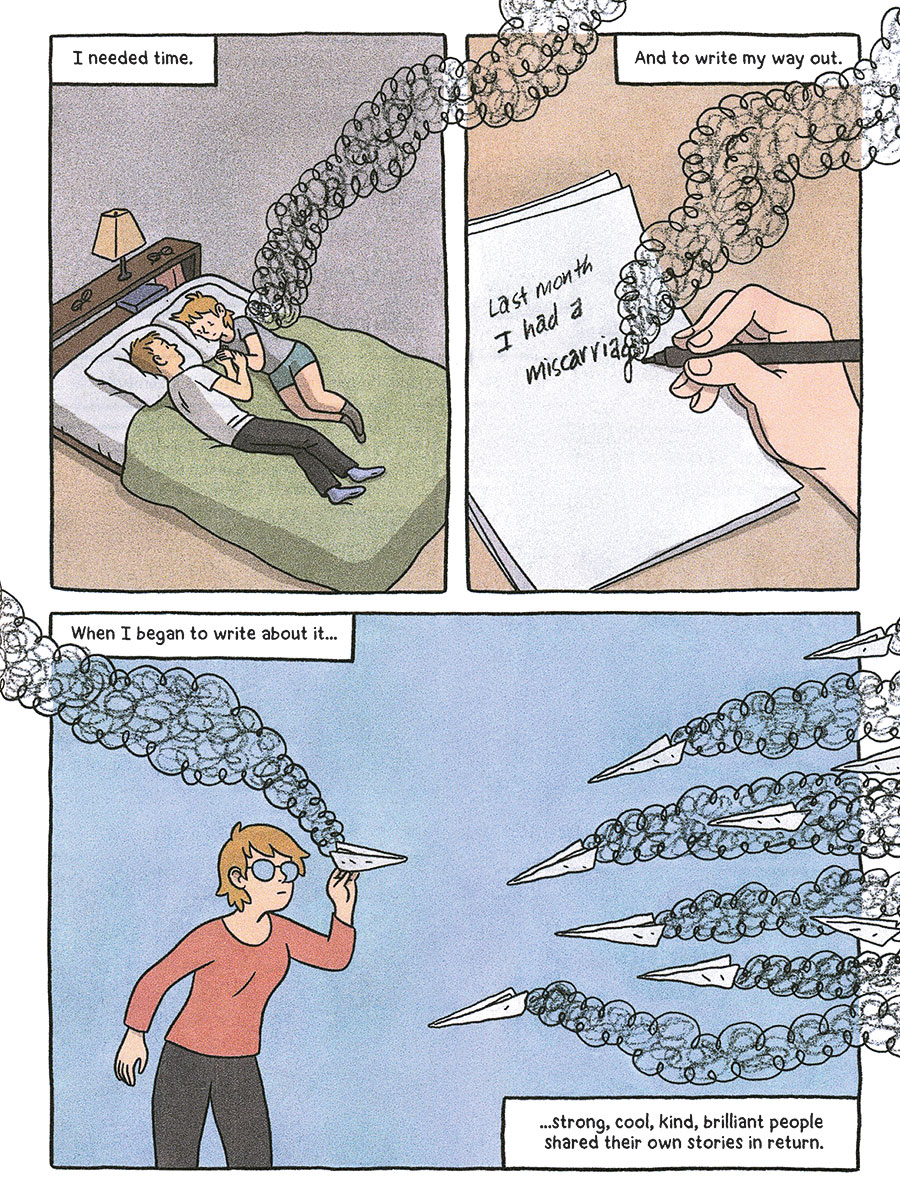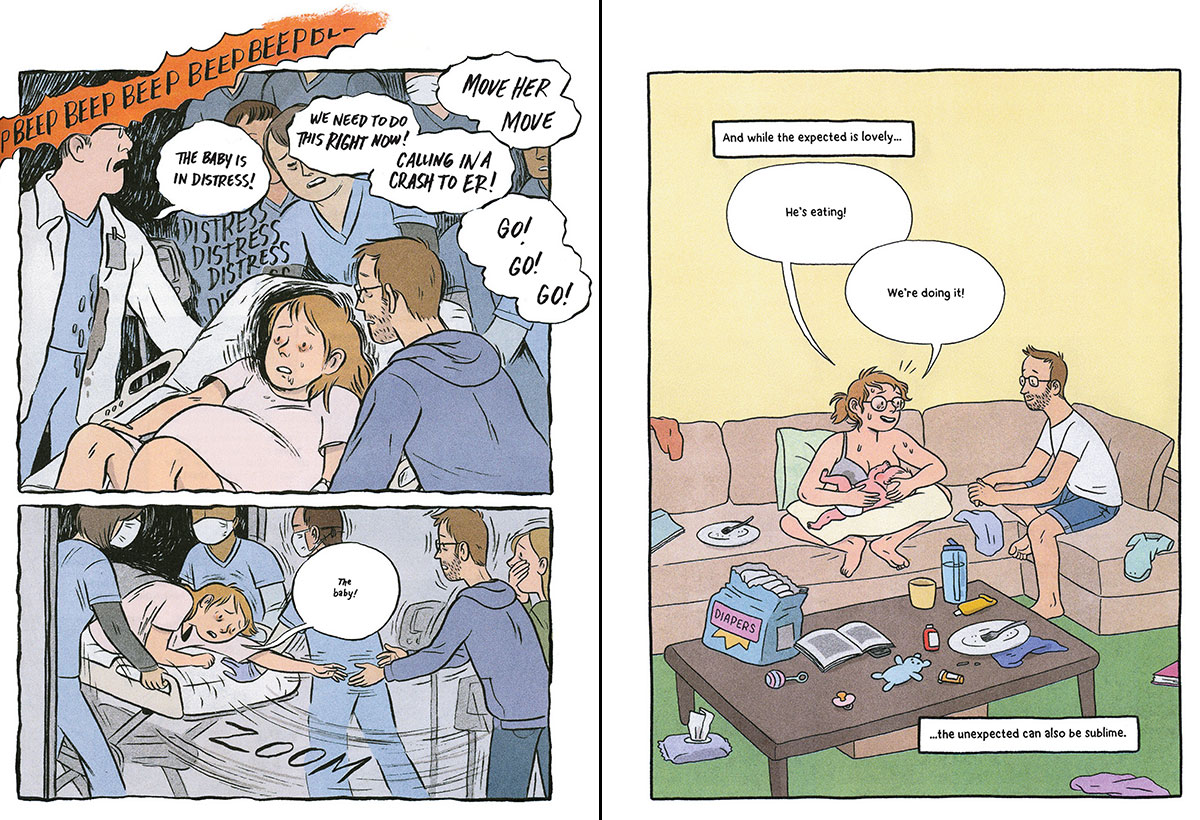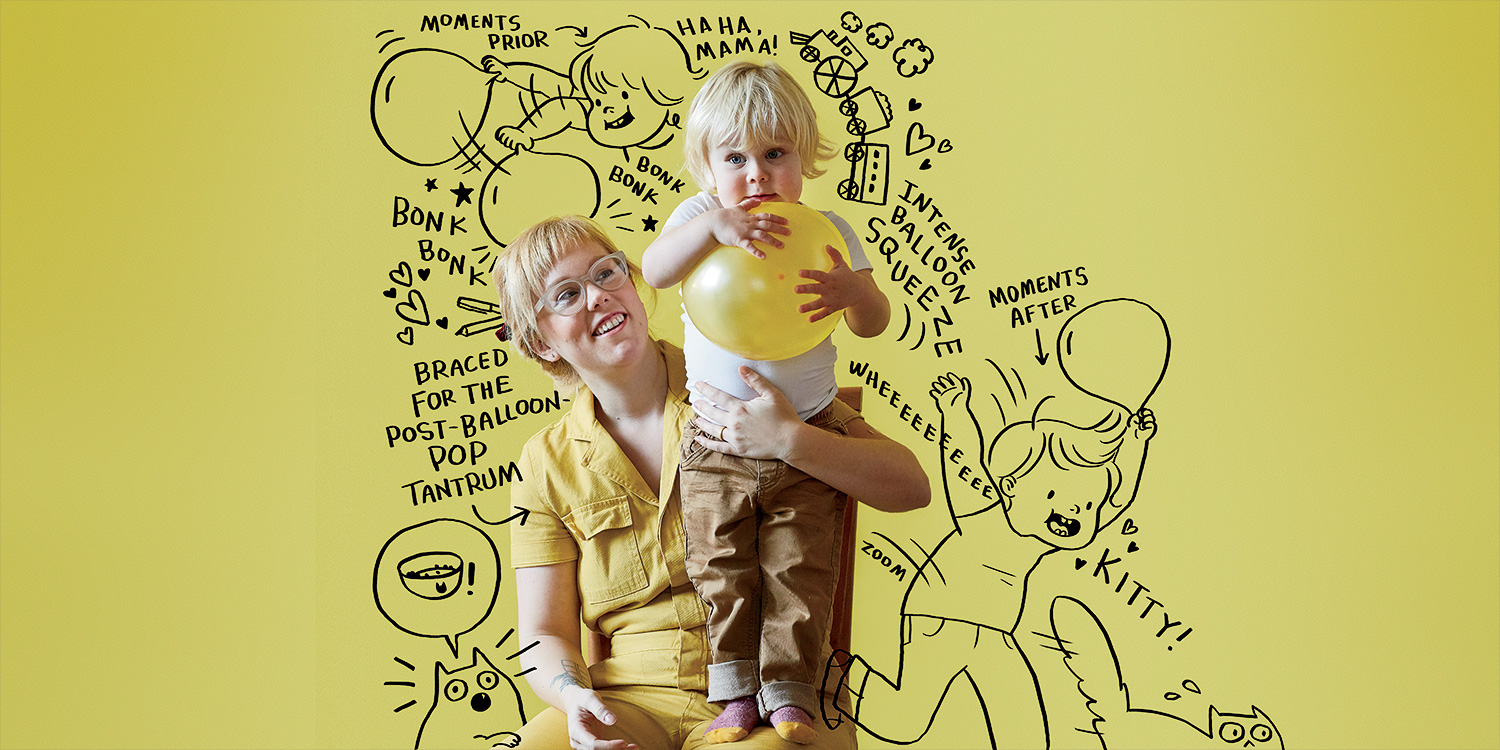Toward the end of Lucy Knisley’s new book, Kid Gloves: Nine Months of Careful Chaos, she ditches her cartoons for a photograph: a black-and-white shot of herself in the ICU, unconscious and hooked up to a heart monitor, a breathing tube, five IVs, and restraints. Coming right at the story’s climax, it’s a shocking contrast to the clean lines and bright colors she otherwise uses to illustrate the sometimes horrid realities of pregnancy and delivery. “I love the interplay of the remembered drawing compared to the photograph,” she says. “It’s like the camera’s memory versus my own.”
Advertisement
The months leading up to that moment provide the bulk of the material for the New York Times best-selling comic artist’s sixth graphic memoir, out February 26, which documents the fertility problems, miscarriages, difficult pregnancy, and dramatic near-death delivery that transitioned the West Town resident into motherhood. But the book also shows that the 33-year-old’s journey to this point began far earlier, in the ’80s and ’90s, when a crash course in sex ed came courtesy of pop culture moments like Look Who’s Talking and high school classes that taught her how to put a condom on a banana. (One early panel in the book shows a panicked teenage Knisley taking notes at a desk, writing “sex = baby and/or AIDS.”) It was enough to inspire what Knisley (pronounced NEIGH-zlee) describes as a fascination with childbearing — as a kid she wanted to be a midwife — but it didn’t provide nearly enough practical education to prepare her for what was to come when she and her husband decided to, as she puts it, “not try but not try not to get pregnant.”
When she finally did get pregnant, Knisley was desperate for a book that honestly discussed the excitement, nerves, and confusion she would grapple with. “I was looking online and there were blogs about natural birth that weren’t really resonating with me, or expectant mothers talking about their angel miracle babies,” she says. “Or I’d find magazine covers that were like ‘My Pregnancy Dream Comes True!’ That wasn’t what I was experiencing. At all.”

Since she couldn’t find it, she wrote it. And Knisley spares no detail, not about the physical turmoil that accompanies those nine months — she represents the “Exorcist levels of puke” of her first trimester by giving comic-book Lucy vomit-green skin — or the emotional ones. Knisley draws herself walking home from the doctor’s office in miniature, primed to be crushed by other commuters after she learned her first pregnancy was just “broken-up bits of baby,” then nearly drowning as she waits for the miscarriage to happen naturally. After her second loss, Knisley is pictured in a deep hole, eventually pulled out by a group of women who’d similarly suffered and emerged whole. (Knisley repeatedly uses images of paper airplanes — hers going into the world, other people’s flying back at her — to show how sharing her story and hearing those of others saved her.)
“Playing with my appearance in the story, I’m allowed to give a better idea of how it felt to exist in that space and time,” explains Knisley. “When I’m small, it can indicate that the world felt big and I felt insignificant, or that I felt dismissed and discarded, like a small piece of flotsam.”
Following an operation to correct a septum in her uterus, Knisley’s third pregnancy was marked by moments that her friends, and even more so her doctor (whom she calls Dr. Fonzie because of his “it’s all good” demeanor), brushed off with a simple “Pregnancy is weird!” There was the first-trimester nausea, but also a pregnancy snore, hands so swollen she had to MacGyver off her wedding ring, blurry vision, and a burning pain in her ribs that made deep breathing impossible. In addition to recounting her own increasingly worrisome symptoms, Knisley weaves in details of the history and politics of reproductive health. Spoiler alert: That past is not pretty. There are hundreds of years of misinformation out there, and maternal mortality is still a real problem. In one chapter, J. Marion Sims, the so-called father of gynecology who tortured and publicly operated on slave women, is illustrated with a shadow in the shape of a monster. Another shows Catherine de’ Medici sitting on a sack of cow manure, a 16th-century fertility measure recommended by a folk healer. “Part of why I included so much of the history is because I felt so alone going through all this, like, ‘This has never happened to another person in the world. I’m a failure as a woman and as a mother that I couldn’t go through this without serious bodily trauma.’ And that’s definitely not true. The whole history of women’s medicine is just riddled with abuse and tragedy and mistakes and awfulness.”

There are lighter moments — Knisley inhabiting “preggo planet” by herself while her friends float away on “child-free fun times planet”; a hugely pregnant Knisley looming over Chicago like Godzilla as bystanders run in fear — but they all lead up to the undiagnosed preeclampsia (and later full-blown eclampsia) that almost killed her after 40 hours of labor and a C-section. She then spent two days unconscious, which she depicts first as a page covered in a mass of black scribbles, then in black-and-white sketches from her husband’s point of view. Knisley says the act of making these creative decisions, whether she’s portraying something dark, humorous, or both, helps her feel sympathy for the person she was in these moments. “What I experienced was no different than what thousands of people have and will experience. And I want to own my particular version of that story and show people that you can live through something terrible and still be you.”
Of course, reliving that something terrible in order to write about it wasn’t easy. Knisley kept a sketchbook during pregnancy, and after a three-month maternity leave, she revisited her drawings. “I had to gather up all these notes and all of these sketches that were like, ‘Ha-ha, you’re my funny little pregnancy foibles,’ and looking back it was like, ‘Oh, that was a sign of my imminent death. That was not a typical pregnancy thing, that was actually me telling my doctor that I had a symptom and him brushing me off.’ ”
In all, the book took her about 18 months to create. “Reliving the most traumatic experience of my life was not great, but I will say that I think it accelerated the processing aspect of it,” Knisley says. Still, she adds, “I don’t recommend spending the year after you give birth traumatically dwelling on every detail of it.”
Advertisement
Two and a half years after her delivery, Knisley is herself again, now with a round-faced, towheaded toddler by her side. Her son loves trucks, books, movies, and “hitting things with sticks” but has no interest in making art. On Thursdays, when it’s just the two of them (he’s in school three days a week, and the nanny comes on Fridays), they go to classes at Mr. Dave Music and shop at their favorite place, Mariano’s (“Every person who works there knows him,” Knisley says).
Every other weekday, Knisley is in her office, working on her many upcoming projects, some of which continue to tap into her motherhood experience. In March, she’ll publish an illustrated baby book titled You Are New (“You can look and see and peer / you can touch and taste and hear”). A collection of sketchbook comics from her son’s first year, Go to Sleep (I Miss You), is slated for 2020. She doesn’t plan to write a graphic memoir about parenting, though, at least not anytime soon. “Maybe in 50 years, when my kid turns into a genius, then I can write safely about parenting. But for now it seems like something that’s so big, it’s hard to put a beginning, middle, and end on it.”
About an hour into our conversation, Knisley’s son (whom she calls Pal in her work because of his palindrome birthday) knocks on the door. “Is it OK to come in?” he calls before waddling in wearing a crown to tell us he is the king. “King sit on the chair!” he proclaims. Just then a puppy appears — the nanny’s new dog — and pees on the carpet. Knisley takes it all in stride. She’s been through worse.



